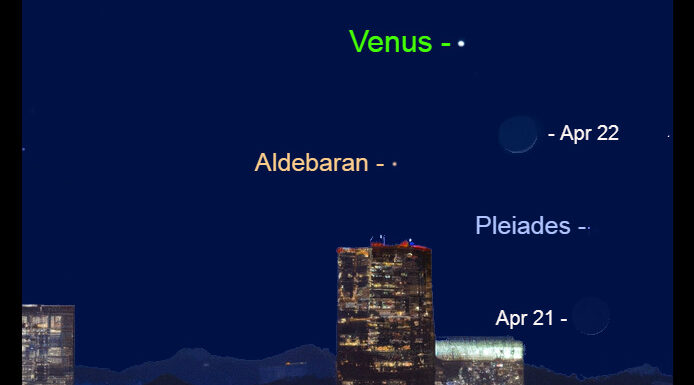
This weekend will offer some cool sky-gazing opportunities, including an “earthshine” on the crescent moon, a star cluster that inspired an auto maker’s logo, and a meteor shower.
Friday through Sunday, the moon will appear as a thin crescent in the western sky shortly after sunset. But sunlight reflecting from the Earth will dimly illuminate the rest of the moon, creating an unusual effect in which the crescent will be bright while the majority of the moon will appear dimly lit, but still visible. The occasional phenomenon is known as “earthshine.”
In addition, the Pleiades, a cluster of stars in the constellation Taurus, will be visible. The Pleiades is depicted in the logo for one of Colorado’s favorite car makes, Subaru.
A nearby star called Aldebaran is the brightest star in the Taurus constellation. And, not to be outdone, the planet Venus — appearing like a bright star — will be prominent nearby.
Shortly after sunset on Friday, the moon will appear as a thin crescent below the Pleiades and Venus will be to the upper left of the Pleiades.
“Through a binocular, the star cluster and the moon fit snugly into the same field,” said Jeff Hunt, a retired Illinois planetarium director whose website (whenthecurveslineup.com) tracks interesting celestial events for amateur sky gazers. “Look for earthshine on the moon — reflected sunlight from Earth’s features that gently illuminates the lunar night.”
On Saturday night, Venus will appear about a third of the way from the western horizon and will be located between Venus and the Pleiades. Earthshine will be visible again. The moon and Venus will fit into the same binocular field.
“Notice the stars that appear near the moon,” Hunt said. “They are outliers of the Hyades star cluster that is to the lower left of the lunar orb. Adjust the binocular slightly in that direction to include Aldebaran, but without the moon in the field. While Aldebaran is not part of the star cluster, it helps us locate it.”
On Sunday night, Venus and the moon will again fit into the same binocular field and earthshine on the moon will be visible again, as will Aldebaran and the Pleiades.
The annual peak of Lyrids meteor shower will also take place in the eastern sky on Friday and Saturday, according to a post on the NASA website. The Lyrids can be expected to produce 18-20 meteors per hour. They are the remnants of a comet that travels a 415-year orbit around the sun. While the comet hasn’t been nearby since 1861, its remnants remain, and the Earth passes through them every year in April.
“Find an area well away from city lights or street lights,” the NASA post suggests. “Come prepared with a sleeping bag, blanket or lawn chair. Lie flat on your back with your feet facing east and look up, taking in as much of the sky as possible. After about 30 minutes in the dark, your eyes will adapt and you will begin to see meteors. Be patient — the show will last until dawn, so you have plenty of time to catch a glimpse.”
Subscribe to our weekly newsletter, The Adventurist, to get outdoors news sent straight to your inbox.
Source: Read Full Article









